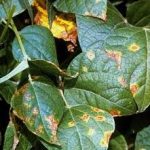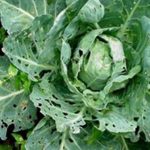VEGETABLE production occurs within a relatively short time-frame and as such yield losses due to pests may be substantial if the problem is not identified early, and remedial action implemented on time. Correct identification of pests and an understanding of their behaviour, including their most vulnerable stages would provide a farmer with appropriate insight into management strategies. The early maturity of vegetables and short intervals between harvests during the cropping season impose constraints on the pest control strategy. Care should, therefore, be taken if pesticide application is contemplated since there is the likelihood of high residual levels remaining in the product after harvest if an inappropriate formulation is used. Also one should use protective gears at all times when administrating pesticides.
Some of the most common vegetable crops widely cultivated across Guyana and are subjected to attack from many insect pests and diseases are Boulanger (commonly called eggplant), hot peppers, bora (also known as string beans) and cabbage. In this week’s edition of NAREI in Focus, we will provide a detailed description of nature on the damage caused by major pests and the appropriate management strategies that may be employed.
Boulanger:
Some of the most common pests and disease which attack the boulanger plants are:
1. Crickets: crickets attack seedlings of almost all vegetables. Various species of these insects usually live both in the soil, bushes and under decaying crop residues and vegetation. All crickets are nocturnal, feeding at night and secluding by day, under the soil. Cultural and chemical methods could be employed for managing crickets, keeping the area free from weeds and removal of crop residue, that there is enough sunlight where the vegetables are grown. Concerning chemical control, any approved soil insecticide at the recommended rate may be applied, such as Basudin 60 % E.C (Diazinon) or Vydate L 40 % at the rate of 10 mls to 4500 mls water to seedbeds and cultivated areas.
2. White Flies: These insects are in fact bugs. The adults are white, moth-like insects that fly upwards from the plant when disturbed. They are about 2mm in length and their wings are covered with a white waxy powder. White Flies can also be controlled using cultural and chemical methods. An integrated control strategy is necessary for the effective management of this pest which includes good farm sanitation. Several new generations of insecticides are now available for the control of whiteflies. Soap-based products which target both nymphs and adults should be applied very early in the morning or late in the evening. Other chemicals which can be used include Admire, Pegasus and or Basudin/Vydate L at 10 mls to 4500 mls water.
Peppers:
Peppers can grow in a wide range of altitudes and are tolerant to a wide range of soil conditions. However, fertile medium loams and well-drained soils with a pH of 5.5-6.8 are most suitable. Some of the most common pests and diseases which attack the pepper plants are:
1. Bacterial Wilt: This is soil-borne bacteria which infect through the roots and invade vascular tissues affecting the plant water supply. Symptoms begin with wilting of the leaves. To safeguard plants from this, you should follow a crop rotation regime and plant only bacteria-free seeds and transplants.
2. Powdery Mildew: This disease is favoured by warm temperatures. Chlorotic blotches or spots appear on the upper leaf surface which may become necrotic. Fungicides have been effective in controlling this disease including Sulphur dust and neem-based products.
Bora:
Bora can be grown in a variety of soils but does best on fertile, well-drained, loose soils with high organic matter content. Like any other crop, the plant is susceptible to attacks.
The most common ones are as follow:
1. Cut Worms: These are the caterpillars of various species of moth. They have a greasy appearance and are grey and brown. Most of its lifecycle is spent below the soil which goes through a period of approximately 21-28 days. Cultural control includes good field sanitation and removal of weeds and plant residues. Any approved soil insecticide at the recommended rate may be applied, such as Basudin 60 % E.C (Diazinon) or Vydate L 40 % at the rate of 10 mls to 4500 mls water to seedbeds and cultivated areas.
2. Bacterial Blight: Common blight-infected leaves turn yellow then brown and drop quickly. The organism is seed-borne. Entry into the plant is through the leaf stomata. Rain and damp weather encourage the development of this disease, however, the disease is more of a problem in warm weather conditions. The bacteria can be controlled utilising cultural and chemical methods and can live in the soil for two years on plant residue. Cultural control includes crop rotation and integrated crop-management approaches. It is also advised to not enter the fields when the foliage is wet to avoid spreading the disease. Bactericides such as Banrot and Mankocide can be used as a form of chemical control.
Cabbage:
Various types of cabbages are grown in Guyana, with the most popular ones being the compact single-leaf type. Cabbage can be grown on any soil type, but is preferably suited to light textured soils (sandy, loam, clay, etc) with high organic matter content. This type of crop does not tolerate acidic conditions. Like any other crop, the plant is susceptible to attacks. The most common ones are as follows:
1 Black Rot: This infection usually occurs near the margin of leaves. Yellow areas develop along the margin, progressing into the leaf. Cabbage is very susceptible to black rot and the interior of the stem may be destroyed by secondary soft rot organisms that attack the black rot infection. Cultural Control includes plant rotation and planting of disease-free seeds that have been treated to eliminate seed-borne bacteria. Mankocide, Rizolex and Banrot can be used as chemical controls.
2. Diamondback Moth:
Diamondback moth is a serious pest of cabbage and other cruciferous crops. The market quality of the crop can be severely reduced by this pest. It damages leaves by feeding the cabbage leaves and heads. Infested leaves are usually riddled with holes. However, like many other crops, there are methods of control. Crop rotation and field sanitation are ways of cultural control. Neem-based products, Decis 2.5% EC-1.5g/litre water, Ambush 5% EC-1 ml/litre water, Karate 2.5% EC-1.5 ml/litre water are some chemical ways for the control of the diamondback moth.



.jpg)














